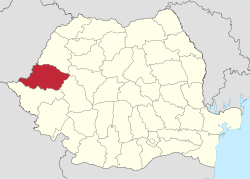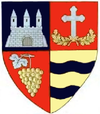| Revision as of 23:49, 17 November 2014 editAfil (talk | contribs)52,654 edits →Hydrographic network← Previous edit | Revision as of 16:17, 2 December 2014 edit undoJohn of Reading (talk | contribs)Autopatrolled, Extended confirmed users, Pending changes reviewers768,040 editsm →Economy: Typo fixing, replaced: of he → of the using AWBNext edit → | ||
| Line 150: | Line 150: | ||
| * Food. | * Food. | ||
| * Textiles. | * Textiles. | ||
| Natural resources in Arad, are worthy to be taken into account as there are oil and associated gases, points of extraction in the west of |
Natural resources in Arad, are worthy to be taken into account as there are oil and associated gases, points of extraction in the west of the county, molibden mines in the Săvârșin area, marble quarries at ] and ], mineral waters at ], ], ], ], ] and uranium deposits in the NE part of the county. | ||
| ==Tourism== | ==Tourism== | ||
Revision as of 16:17, 2 December 2014
For other uses, see Arad (disambiguation). County in Vest, Romania| Arad County Județul Arad | |
|---|---|
| County | |
 Coat of arms Coat of arms | |
 Location of Arad County in Romania Location of Arad County in Romania | |
| Country | |
| Development region | Vest |
| Historic region | Crișana |
| Capital city (Reședința de județ) | Arad |
| Județul Arad | 1968 |
| Government | |
| • Type | County Council |
| • President of the County Board | Nicolae Ioțcu (PDL) |
| • Prefect | Călin Bibarț |
| Area | |
| • Total | 7,754 km (2,994 sq mi) |
| • Rank | 5th in Romania |
| Elevation | 1,486 m (4,875 ft) |
| Population | |
| • Total | 409,072 |
| • Rank | 21st in Romania |
| • Density | 53/km (140/sq mi) |
| Time zone | UTC+2 (EET) |
| • Summer (DST) | UTC+3 (EEST) |
| Postal Code | 31wxyz |
| Area code | +40 x57 |
| Car Plates | AR |
| GDP | US$ 5.24 billion (2008) |
| GDP/capita | US$ 11,337 (2008) |
| Website | County Council County Prefecture |
| The development regions of Romania have no administrative role and were formed in order to manage funds from the European Union. as of 2007, the Prefect is not a politician, but a public functionary. He (or she) is not allowed to be a member of a political party, and is banned from having any political activity in the first six months after his resignation (or exclusion) from the public functionaries' corps. w, x, y, and z are digits that indicate the city, the street, part of the street, or eaven the building of the address x is a digit indicating the operator: 2 for the former national operator, Romtelecom, and 3 for the other ground telephone networks used on both the plates of the vehicles that operate only in the county limits (like utilitary vehicles and ATVs, etc.), and the ones used outside the county | |
Arad (Template:IPA-ro) is an administrative division (judeţ) of Romania roughly translated into county in the western part of the country on the border with Hungary, mostly in the region of Crișana and few villages in Banat. The administrative center of the county lies in the city of Arad. The Arad County is part of the Danube-Kris-Mures-Tisza Euroregion.
Name
In Hungarian, it is known as Arad megye, in Serbian as Арад / Arad, and in German as Kreis Arad. The county was named after its administrative center, Arad.
Geography
The county has a total area of 7,754 km², representing 3.6% of national Romanian territory. The terrain of Arad County is divided into two distinct units that cover almost half of the county each. The eastern side of the county has a hilly to low mountainous terrain (Dealurile Lipovei, Munții Zărandului, Munții Codru Moma) and on the western side it's a plain zone consisting of the Arad Plain, Low Mures Plain, and The High Vinga Plain. Taking altitude into account we notice that it follows a stepped pattern as it drops as we go from the east to the west of the county from 1489 m to below 100 m. In the east there are the Zarand Mountainsnand the Codru Moma Mountains, all subdivisions of the Apuseni Mountains, a major group of the Western Carpathians.
Neighbours
- Alba County and Hunedoara County to the East.
- Hungary to the West - Békés and Csongrád Counties.
- Bihor County to the North.
- Timiș County to the South.
Climate and precipitation
In terms of climate, the characteristics of Arad county have a typical temperate continental climate with oceanic influences, with a circulation of air masses with a predominantly western ordered direction visible from west to east, with increasing altitude. Average annual temperatures range from 10 °C in the lowlands, the hills and piedmonts 9 °C, 8 °C and 6 °C in the low mountains in the area of greatest height. Average amounts of precipitation fall in values between 565–600 mm annually in the lowlands, 700–800 mm annually in the hills and piedmonts and 800–1200 mm annually in the mountainous area.
Hydrographic network
The hydrographic network is composed of the two main rivers plus their tributaries and channels.
- Mureṣ - Corbeasca, Troaş, Bârzava, Milova, Cladova
- Criṣul Alb - Hălmăgel, Valea Leucii, Tăcaşele, Cremenoasa, Zimbru, Valea Deznei, Valea Monesei, Tălagiu, Honțisor, Chişindia, Cigher
Lakes, ponds and channels
- Tauț, Seleuș, Cermei, Rovine, Matca (Ghioroc) Lakes and Gypsy Pond
- Matca, Canalul Morilor, Canalul Morilor, Ier, Criș Channels
Demographics
In 1720, the population was as follows - 374 houses:
- 177 Romanian (47.33%)
- 162 Serb (43.31%)
- 35 Hungarian (9.36%)
In October 31, 2011, it had a population of 409,072 and the population density was 52/km². The main ethnic composition was, as follows:
- Romanians - 83.88%
- Hungarians - 9.06%
- Roma - 4.04%
| Year | County population |
|---|---|
| 1948 | 476,207 |
| 1956 | 475,620 |
| 1966 | 481,248 |
| 1977 | 512,020 |
| 1992 | 487,370 |
| 2002 | 461,791 |
| 2011 | 409,072 |
Economy
Along with Timiș County it forms one of the most developed regions in Romania. Due to its proximity to the border, it attracts a great number of foreign investments. The agricultural potential is greatly put into value, Arad plains being considered one of the most important cereal and vegetable producing basins.
The predominant industries in the county are:
- Machine and automotive components.
- Food.
- Textiles.
Natural resources in Arad, are worthy to be taken into account as there are oil and associated gases, points of extraction in the west of the county, molibden mines in the Săvârșin area, marble quarries at Căprioara and Moneasa, mineral waters at Lipova, Moneasa, Dorobanți, Curtici, Macea and uranium deposits in the NE part of the county.
Tourism
The main tourist destinations are:
- The city of Arad
- The Mureș Natural Floodplain Park
- Bezdin Monastery
- Hodoș-Bodrog Monastery (est. 1177)
- Lipova resort and city
- Șoimoș, Dezna, Șiria stone citadels
- Moneasa resort
- The areas around Săvârșin, Petriș, Macea and Pecica.
Administrative divisions
Arad County has 1 municipality, 9 towns and 68 communes with approximately 180 villages.
- Municipalities
- Arad - capital city; population: 172,827 (as of 2002)
- Towns
- Communes
- Almaș
- Apateu
- Archiș
- Bata
- Bârsa
- Bârzava
- Beliu
- Birchiș
- Bocsig
- Brazii
- Buteni
- Cărand
- Cermei
- Chisindia
- Conop
- Covăsânț
- Craiva
- Dezna
- Dieci
- Dorobanți
- Fântânele
- Felnac
- Frumușeni
- Ghioroc
- Grăniceri
- Gurahonț
- Hălmagiu
- Hălmăgel
- Hășmaș
- Ignești
- Iratoșu
- Livada
- Macea
- Mișca
- Moneasa
- Olari
- Păuliș
- Peregu Mare
- Petriș
- Pilu
- Pleșcuța
- Săvârșin
- Secusigiu
- Seleuș
- Semlac
- Sintea Mare
- Socodor
- Șagu
- Șeitin
- Șepreuș
- Șicula
- Șilindia
- Șimand
- Șiria
- Șiștarovăț
- Șofronea
- Tauț
- Târnova
- Ususău
- Vărădia de Mureș
- Vârfurile
- Vinga
- Vladimirescu
- Zăbrani
- Zădăreni
- Zărand
- Zerind
- Zimandu Nou
References
Notes
- http://www.recensamantromania.ro/wp-content/uploads/2012/02/Comunicat_DATE_PROVIZORII_RPL_2011.pdf
- National Institute of Statistics, "Populaţia la recensămintele din anii 1948, 1956, 1966, 1977, 1992, 2002 şi 2011"
